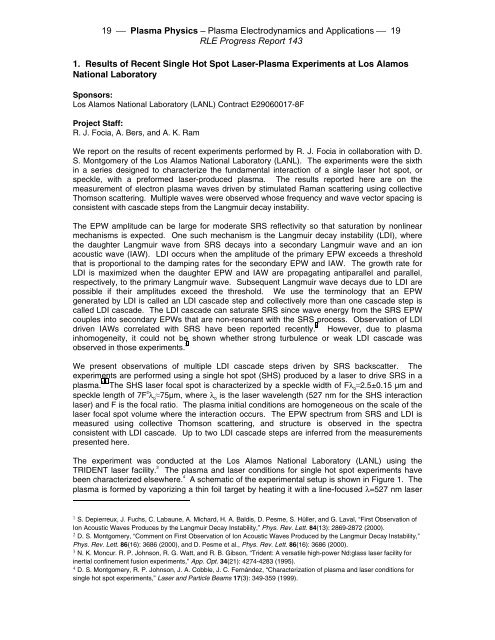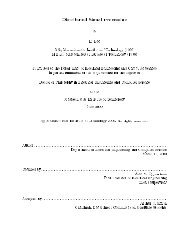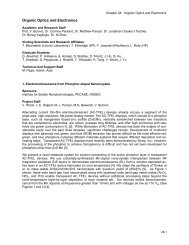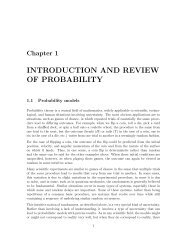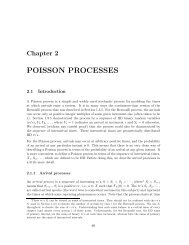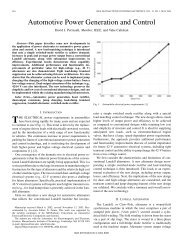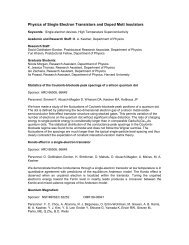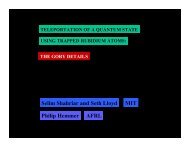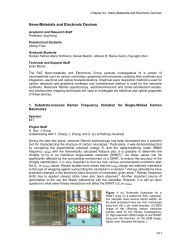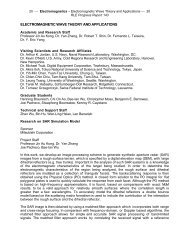RLE Progress Report No - Research Laboratory of Electronics - MIT
RLE Progress Report No - Research Laboratory of Electronics - MIT
RLE Progress Report No - Research Laboratory of Electronics - MIT
Create successful ePaper yourself
Turn your PDF publications into a flip-book with our unique Google optimized e-Paper software.
1. Results <strong>of</strong> Recent Single Hot Spot Laser-Plasma Experiments at Los Alamos<br />
National <strong>Laboratory</strong><br />
Sponsors:<br />
Los Alamos National <strong>Laboratory</strong> (LANL) Contract E29060017-8F<br />
Project Staff:<br />
R. J. Focia, A. Bers, and A. K. Ram<br />
We report on the results <strong>of</strong> recent experiments performed by R. J. Focia in collaboration with D.<br />
S. Montgomery <strong>of</strong> the Los Alamos National <strong>Laboratory</strong> (LANL). The experiments were the sixth<br />
in a series designed to characterize the fundamental interaction <strong>of</strong> a single laser hot spot, or<br />
speckle, with a preformed laser-produced plasma. The results reported here are on the<br />
measurement <strong>of</strong> electron plasma waves driven by stimulated Raman scattering using collective<br />
Thomson scattering. Multiple waves were observed whose frequency and wave vector spacing is<br />
consistent with cascade steps from the Langmuir decay instability.<br />
The EPW amplitude can be large for moderate SRS reflectivity so that saturation by nonlinear<br />
mechanisms is expected. One such mechanism is the Langmuir decay instability (LDI), where<br />
the daughter Langmuir wave from SRS decays into a secondary Langmuir wave and an ion<br />
acoustic wave (IAW). LDI occurs when the amplitude <strong>of</strong> the primary EPW exceeds a threshold<br />
that is proportional to the damping rates for the secondary EPW and IAW. The growth rate for<br />
LDI is maximized when the daughter EPW and IAW are propagating antiparallel and parallel,<br />
respectively, to the primary Langmuir wave. Subsequent Langmuir wave decays due to LDI are<br />
possible if their amplitudes exceed the threshold. We use the terminology that an EPW<br />
generated by LDI is called an LDI cascade step and collectively more than one cascade step is<br />
called LDI cascade. The LDI cascade can saturate SRS since wave energy from the SRS EPW<br />
couples into secondary EPWs that are non-resonant with the SRS process. Observation <strong>of</strong> LDI<br />
driven IAWs correlated with SRS have been reported recently. 1<br />
However, due to plasma<br />
inhomogeneity, it could not be shown whether strong turbulence or weak LDI cascade was<br />
observed in those experiments. 2<br />
We present observations <strong>of</strong> multiple LDI cascade steps driven by SRS backscatter. The<br />
experiments are performed using a single hot spot (SHS) produced by a laser to drive SRS in a<br />
plasma. 3,4 The SHS laser focal spot is characterized by a speckle width <strong>of</strong> Fλ 0<br />
≈2.5±0.15 µm and<br />
speckle length <strong>of</strong> 7F 2 λ 0<br />
≈75µm, where λ 0<br />
is the laser wavelength (527 nm for the SHS interaction<br />
laser) and F is the focal ratio. The plasma initial conditions are homogeneous on the scale <strong>of</strong> the<br />
laser focal spot volume where the interaction occurs. The EPW spectrum from SRS and LDI is<br />
measured using collective Thomson scattering, and structure is observed in the spectra<br />
consistent with LDI cascade. Up to two LDI cascade steps are inferred from the measurements<br />
presented here.<br />
The experiment was conducted at the Los Alamos National <strong>Laboratory</strong> (LANL) using the<br />
TRIDENT laser facility. 3<br />
The plasma and laser conditions for single hot spot experiments have<br />
been characterized elsewhere. 4<br />
A schematic <strong>of</strong> the experimental setup is shown in Figure 1. The<br />
plasma is formed by vaporizing a thin foil target by heating it with a line-focused λ=527 nm laser<br />
1 S. Depierreux, J. Fuchs, C. Labaune, A. Michard, H. A. Baldis, D. Pesme, S. Hüller, and G. Laval, “First Observation <strong>of</strong><br />
Ion Acoustic Waves Produces by the Langmuir Decay Instability,” Phys. Rev. Lett. 84(13): 2869-2872 (2000).<br />
2 D. S. Montgomery, “Comment on First Observation <strong>of</strong> Ion Acoustic Waves Produced by the Langmuir Decay Instability,”<br />
Phys. Rev. Lett. 86(16): 3686 (2000), and D. Pesme et al., Phys. Rev. Lett. 86(16): 3686 (2000).<br />
3 N. K. Moncur. R. P. Johnson, R. G. Watt, and R. B. Gibson, “Trident: A versatile high-power Nd:glass laser facility for<br />
inertial confinement fusion experiments,” App. Opt. 34(21): 4274-4283 (1995).<br />
4 D. S. Montgomery, R. P. Johnson, J. A. Cobble, J. C. Fernández, “Characterization <strong>of</strong> plasma and laser conditions for<br />
single hot spot experiments,” Laser and Particle Beams 17(3): 349-359 (1999).


